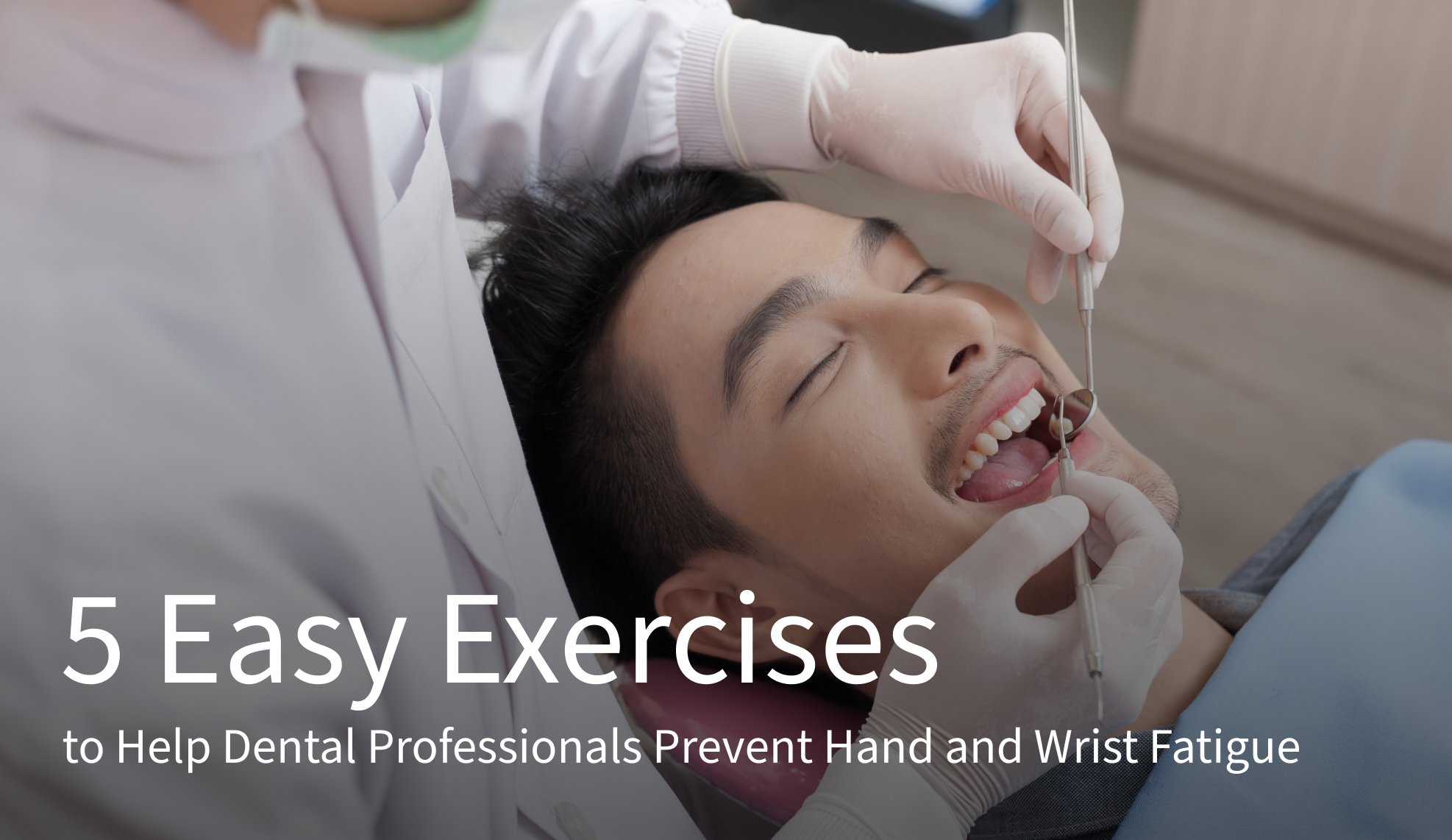Editor’s Note: This blog was updated in 2022 to include additional exercises to help promote healthy hands and wrists. Find those down below the original five tried-and-true methods.
Many dentists and dental hygienists work for hours performing repetitive movements with their hands and wrists. Grasping the same instruments all day for the majority of your work means the need for some counter measures. As one would expect, over time many develop musculoskeletal disorders that cause the bones and muscles in their hands and wrists to fatigue and, in later stages, exhibit chronic pain. In fact, research shows that 82.7% of dental professionals reported at least one symptom of musculoskeletal disease in the past 12 months.1
However, there is light at the end of the tunnel; because there are many preventative measures, exercises, and remedies that can help to ease and even overcome hand and wrist fatigue (if consistently put into practice).
Here are a few easy exercises that, when done every day or at least multiple times per week, help dentists and hygienists keep their hands and wrists flexible, strong, and free of pain. (Note: If you experience extreme pain during an exercise, skip that exercise. And also be sure to check-in with your physician.)
Fist Clench

Standing with your arms straight out in front of you, your fingers spread, and your palms facing each other, slowly make fists with your hands by curling your fingers toward you and tucking your thumbs under your fingers. Inhale as you extend your fingers wide (very slowly), and exhale slowly as you clench them. Repeat this 5–10 times.
Wrist Stretch

Standing or sitting upright, stretch one arm out in front of you with your wrist cocked back, palm facing forward, and fingers pointing up as if to make a “stop” gesture. Then, with your other hand pull back very gently on the fingers—stretching the wrist and arm. Hold the position for a few seconds and then relax. Repeat ten times.
Next, turn your hand downward, with the top of your hand facing out, your palm facing you, and your fingers pointing toward the ground. With your free hand, very gently press on the front of the hand, bringing it toward your body. Hold for a few seconds and then relax. Repeat ten times.
Finger Lifts
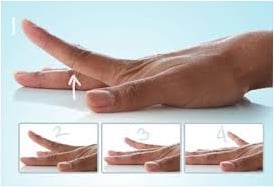
Place one hand palm down on the table with fingers moderately spread. Beginning with the thumb, lift each finger slowly off the table one at a time. Hold each finger up for a second or two before lowering it. Repeat with each finger on the left hand, then perform the exercise on the right hand.
Finger Touches
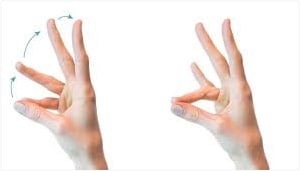
Open your hand with your fingers spread apart. Touch your thumb to your pinky, then open your hand back up to the starting position. Continue touching the end of each finger with your thumb, opening the hand wide between each touch. Repeat on the opposite hand. Do this three times on each hand.
With your hands in the “thumbs up” position, rotate thumbs in a circular motion. After a few seconds, switch the direction of the rotation (i.e., from clockwise to counterclockwise) to exercise your full range of motion.
Thumb Circles

With your hands in the “thumbs up” position, rotate thumbs in a circular motion. After a few seconds, switch the direction of the rotation (i.e., from clockwise to counterclockwise) to exercise your full range of motion.
Figure Eights
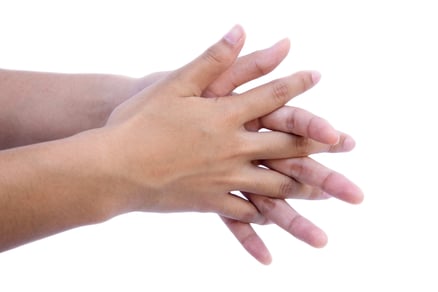
Place your hands in front of your body and interlace your fingers. Move your hands in a figure eight motion while ensuring your elbows stay tight to your side. Your wrists should fully rotate, so that each take turns on top and bottom. Do this for 10–15 seconds, pause, and repeat as necessary.
Adapted Eagle Pose

Place your arms straight in front of you, running parallel to the floor. Place your right arm over the top of your left arm and bend your elbows. Move the right elbow inside the bend of your left elbow and make sure the backs of your hands are in contact with each other. Alternate leaning your right arm to the right and your left arm to the left. Your right thumb should pass by the pinky finger of your left hand. Now your palms should be facing each other, so press them together, raise your elbows, and feel the stretch in your fingers toward the sky. Try to keep your shoulders down, no matter how much you may feel like you need to raise them. Hold this pose for 15–30 seconds, then repeat on the other side.
Use Quality Equipment
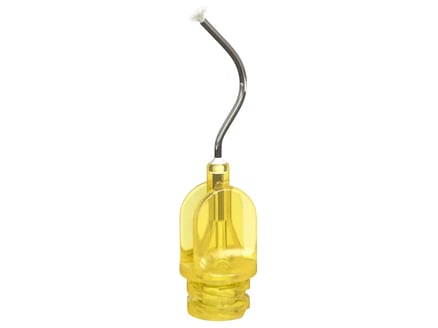
Utilizing products designed with ergonomics in mind can help mitigate hand and wrist fatigue as well. Actions like repeatedly attaching and removing dental syringe tips can be taxing on fingers. To combat this, we’ve updated our Metal Dento-Infusor™ tip with an ergonomic Comfort Hub™ feature. This allows for easy attachment and removal.
Tips usually have little surface area for fingers to grab (and sometimes require significant torque to attach and remove). The Comfort Hub feature increases the surface area to grasp while offering a slightly concave, ergonomic hub—dramatically improving ease-of-use. While attaching or removing the tip, greater torque can be applied with less finger stress and discomfort.
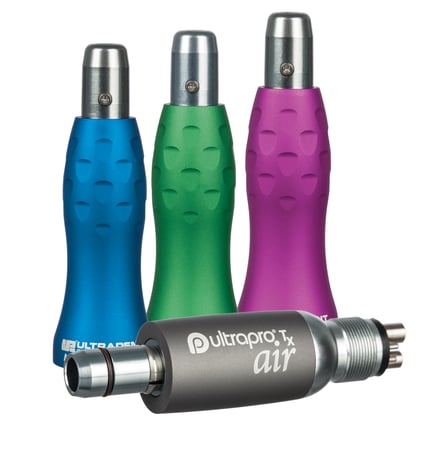
You can also use a handpiece like Ultradent’s Ultrapro™ Tx Air handpiece which features a soft-start motor, reduced hand vibration, and ergonomic grip. These reduce pressure and tension on the hand and wrist.
1.Baltic Dental and Maxillofacial Journal, 2007 Volume 9, No. 1


